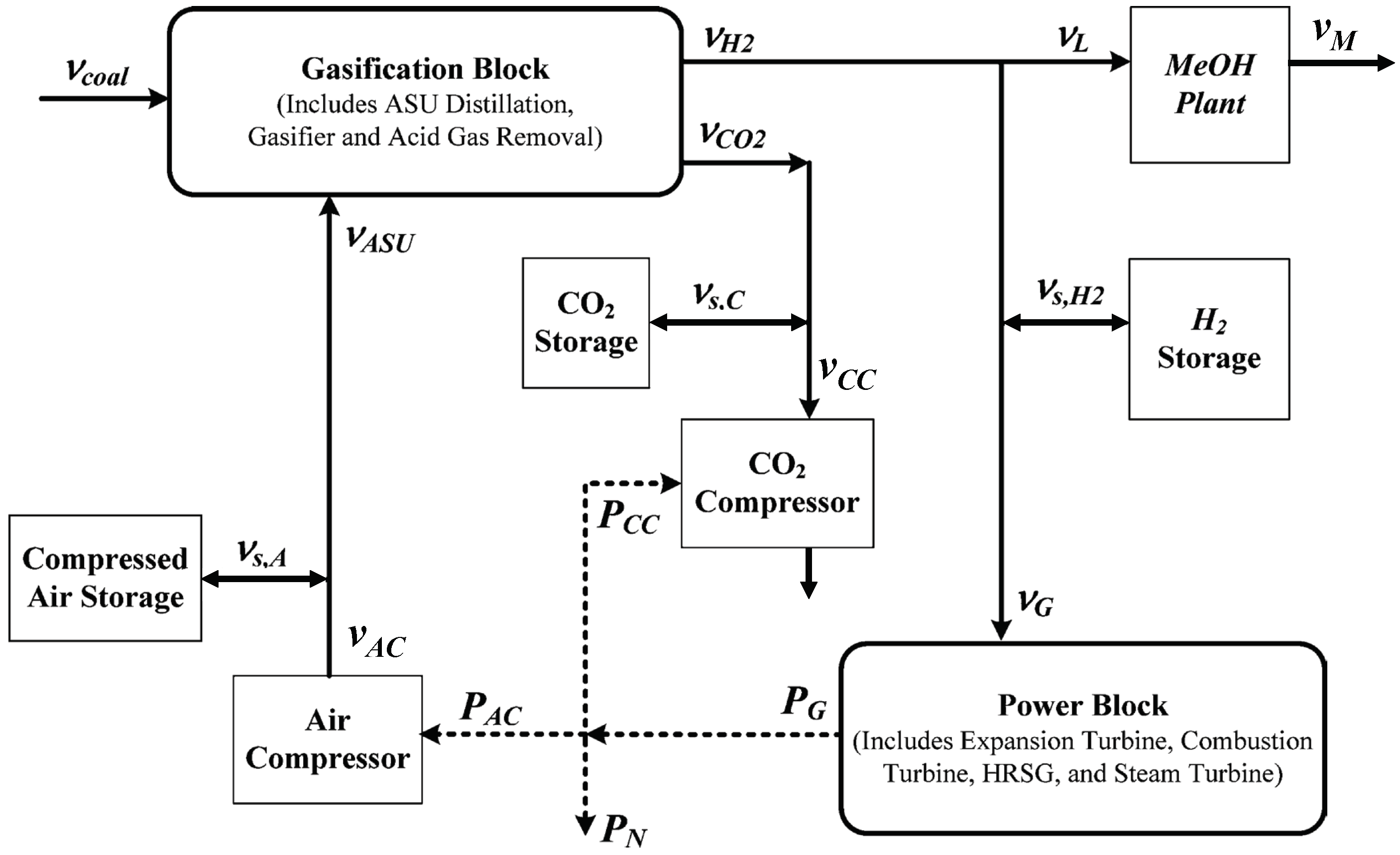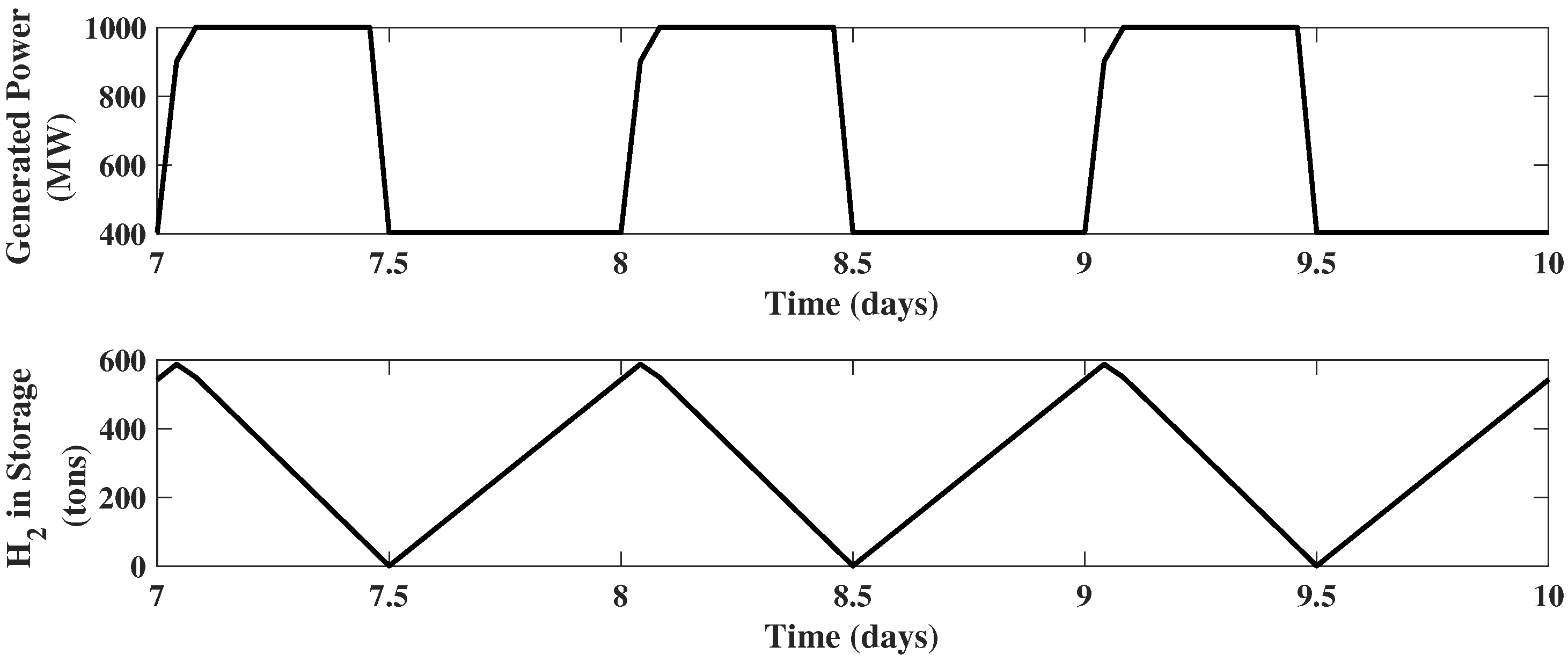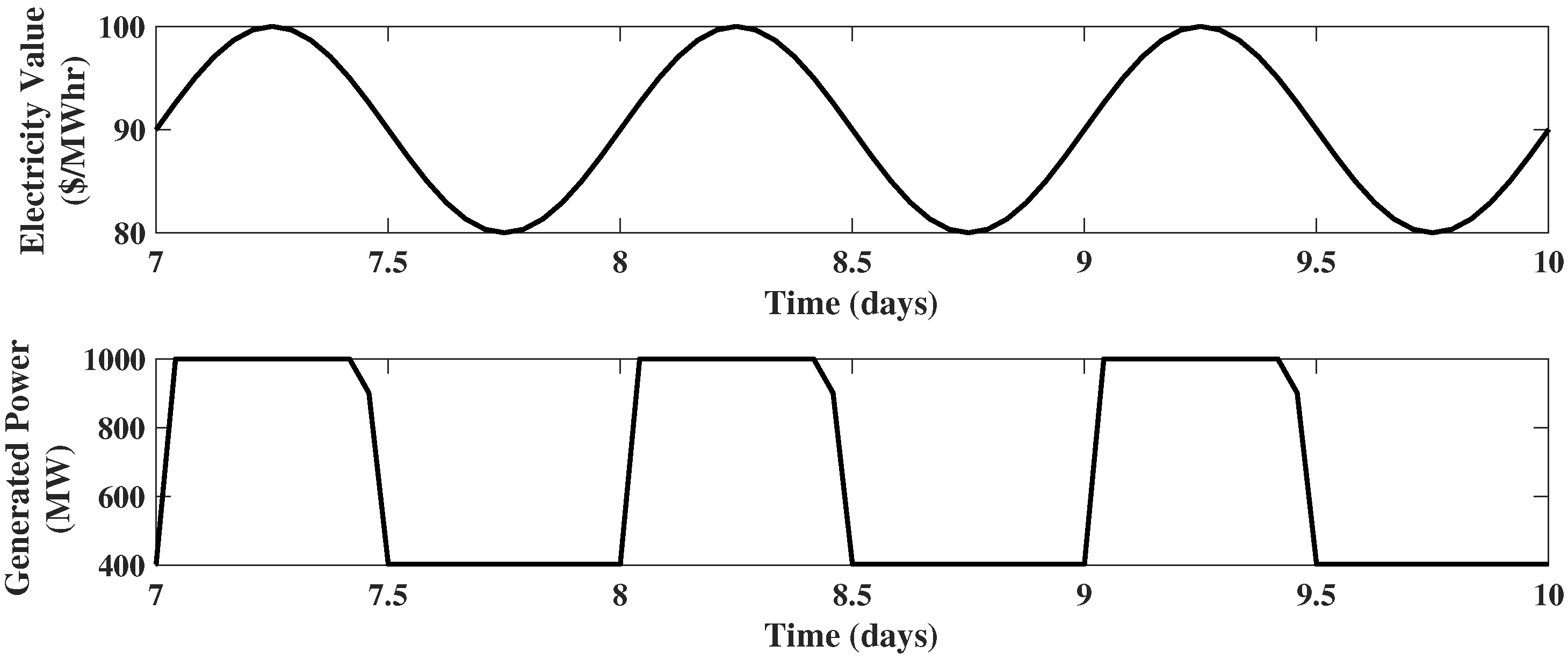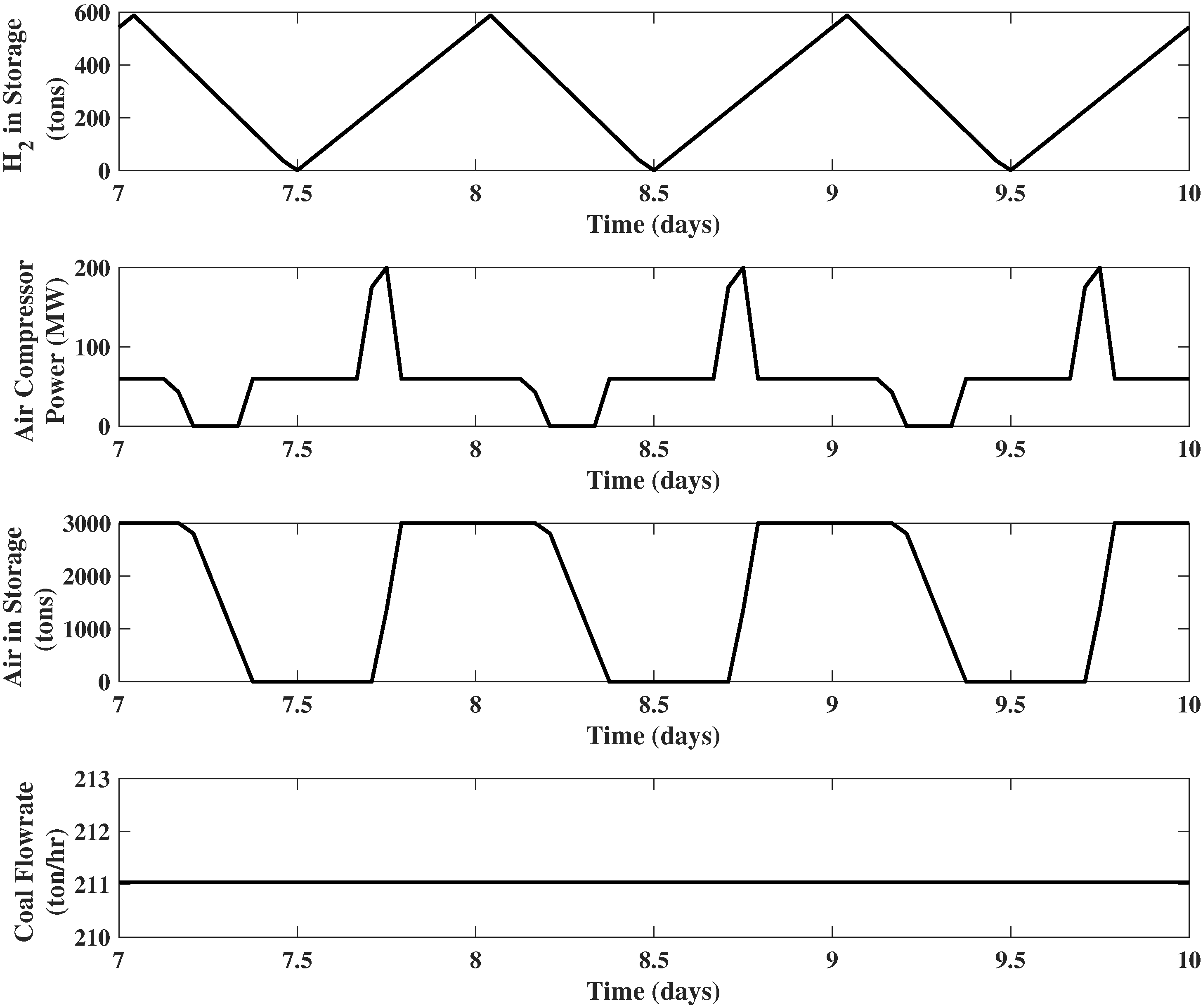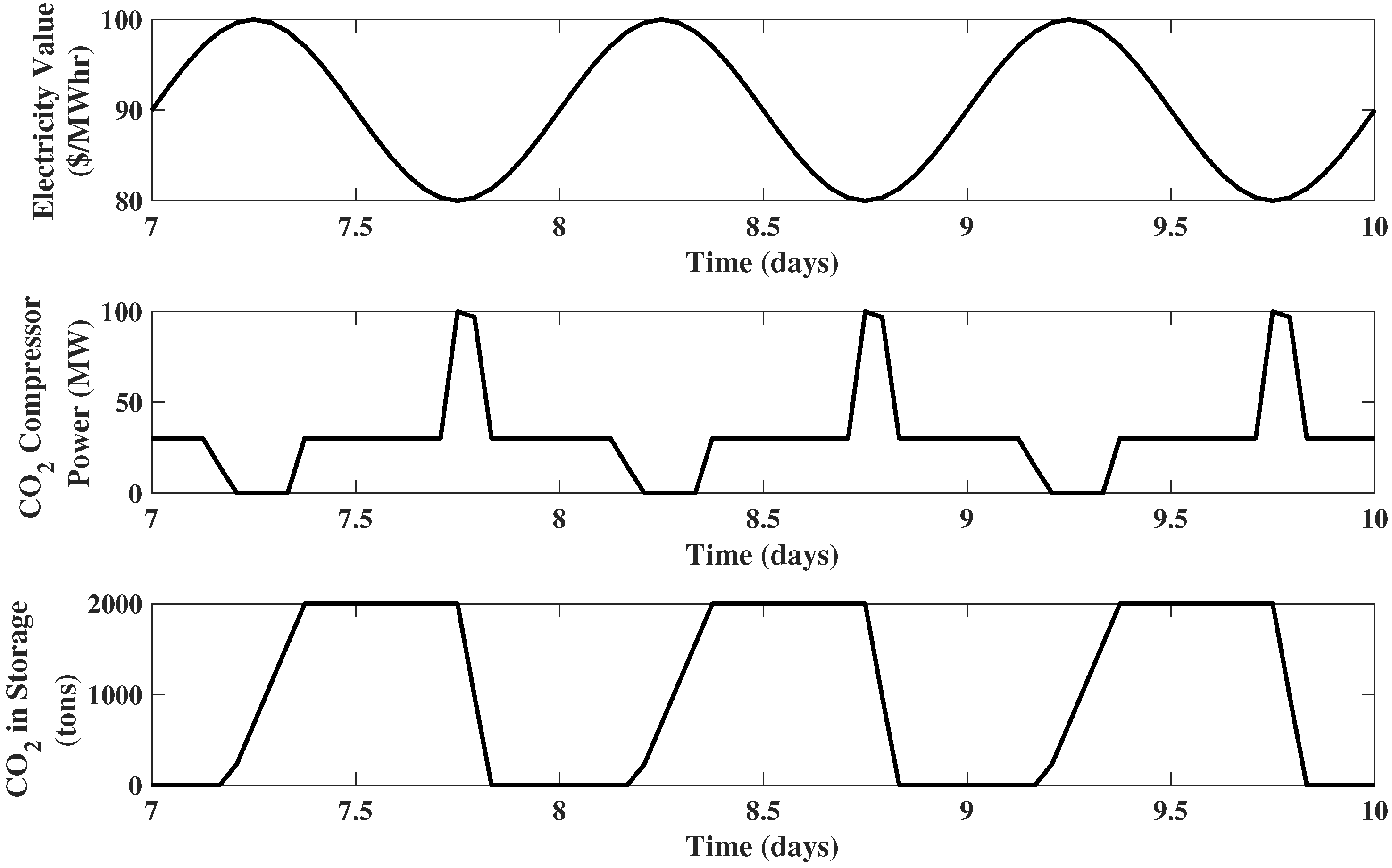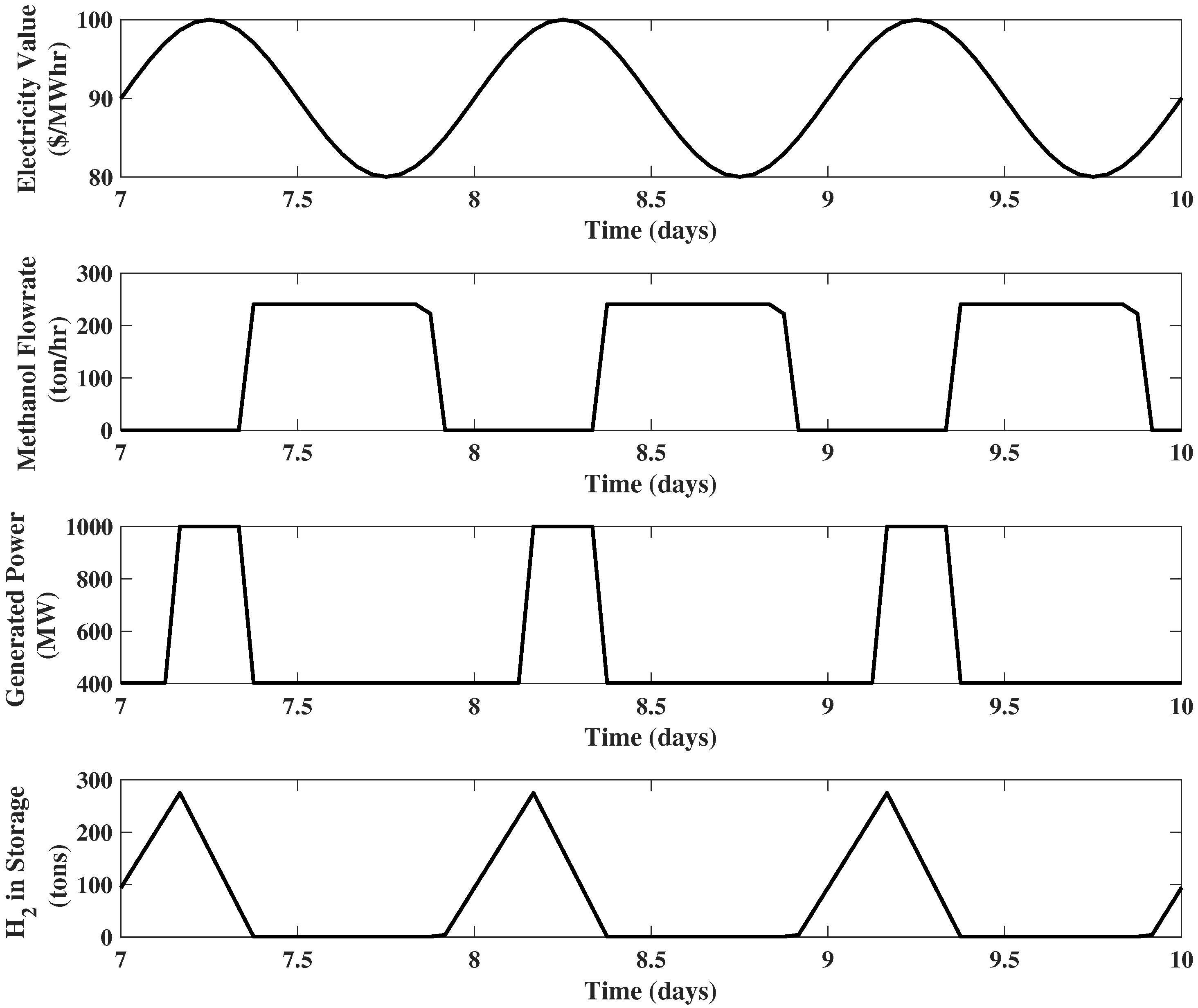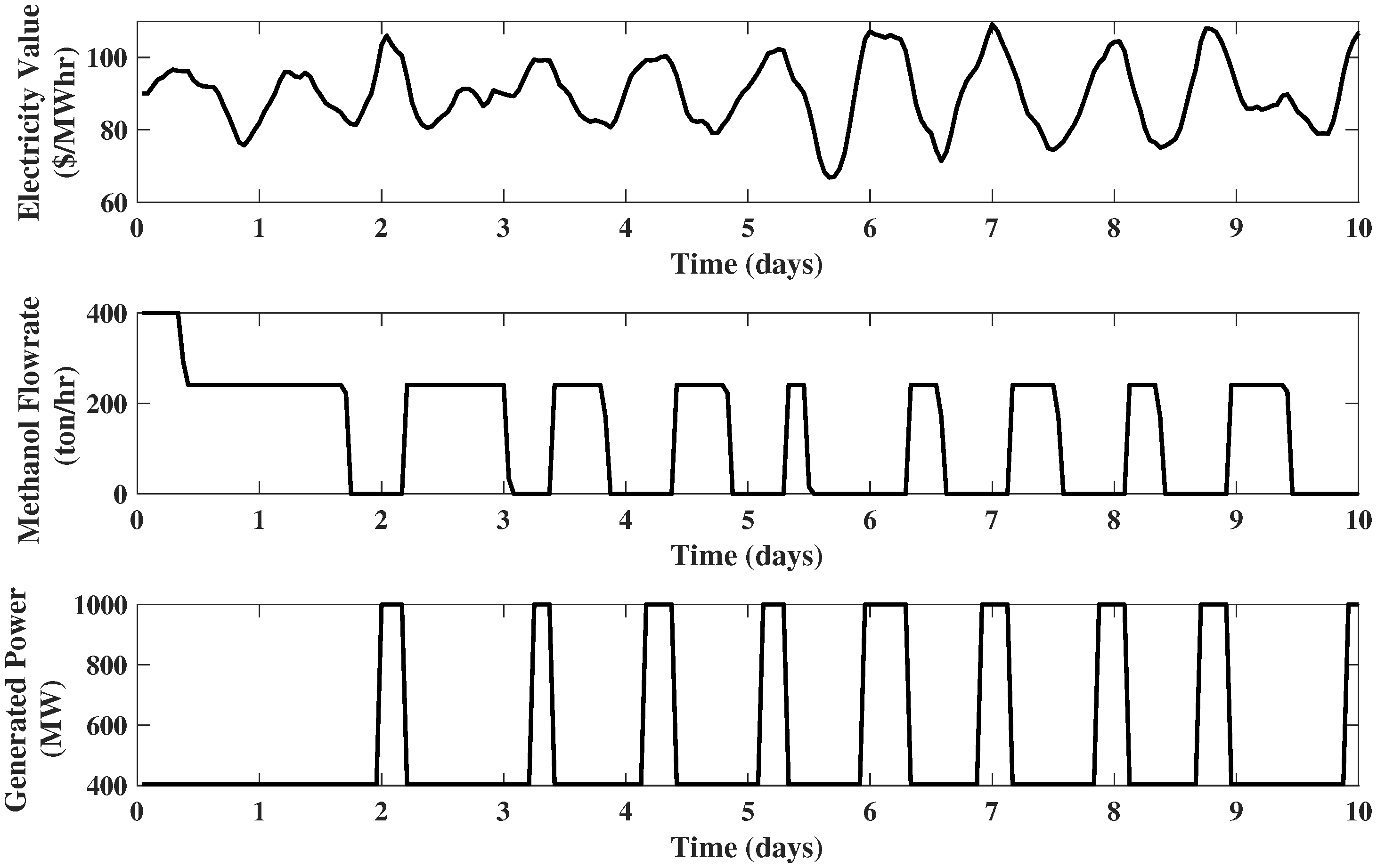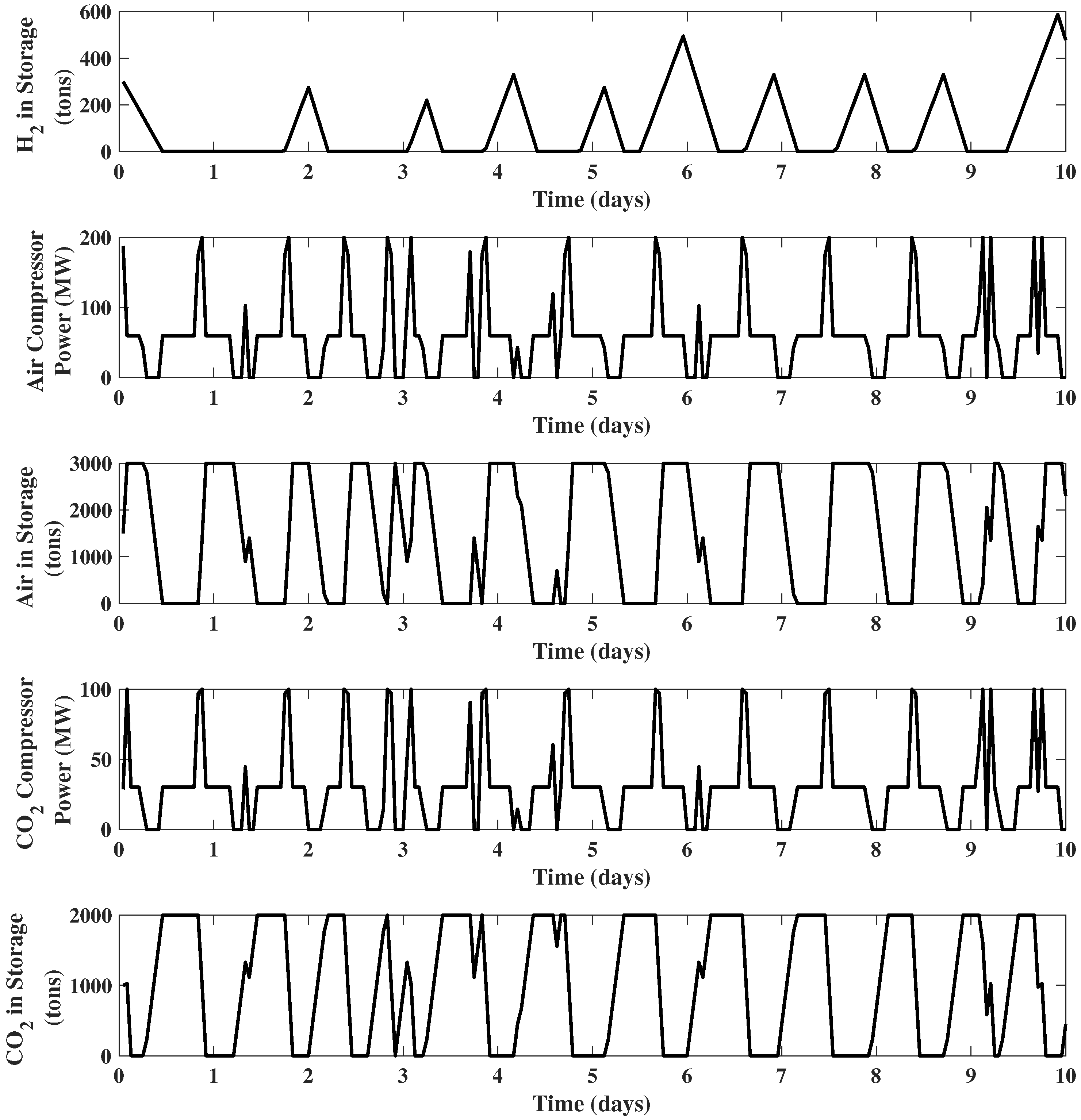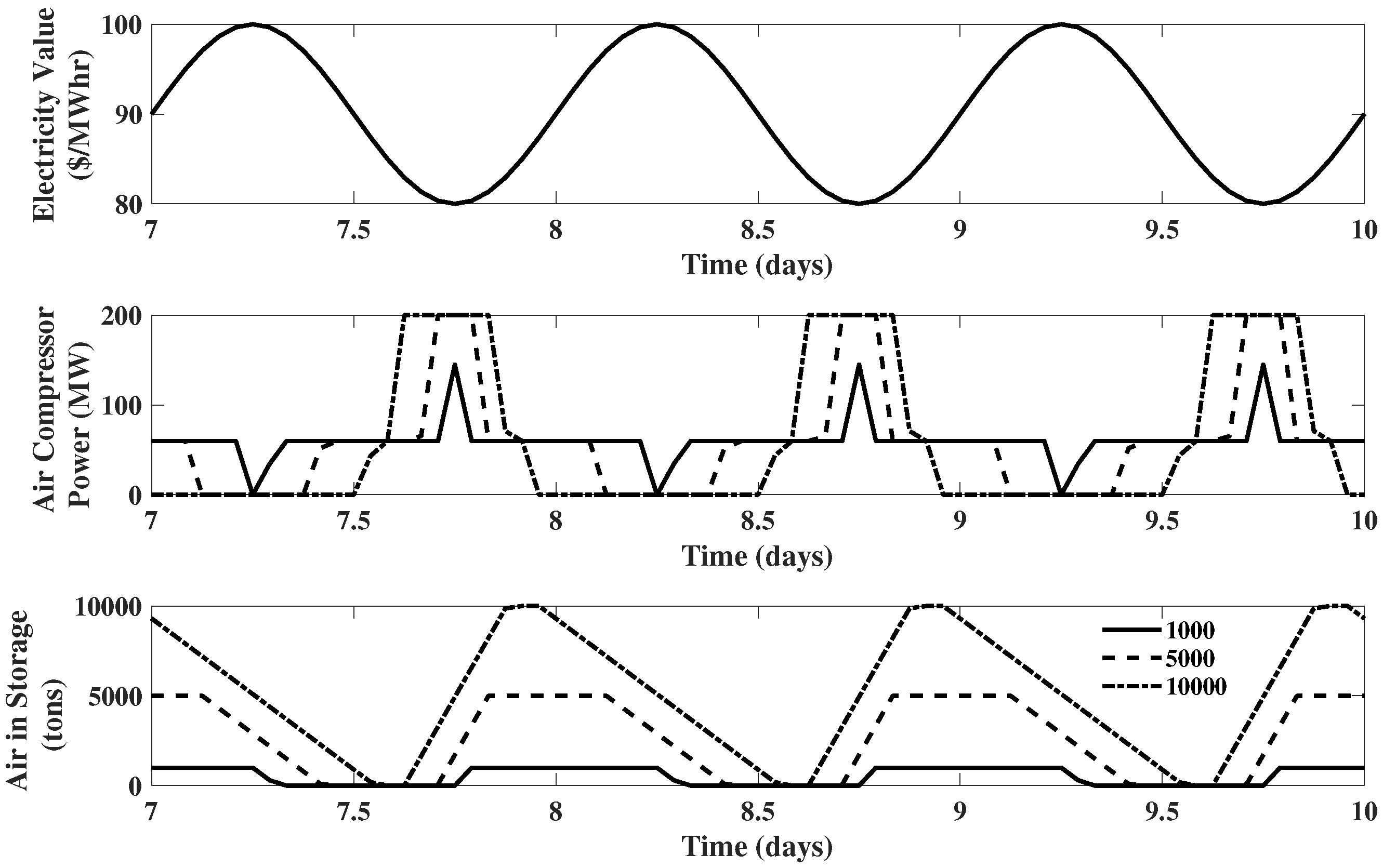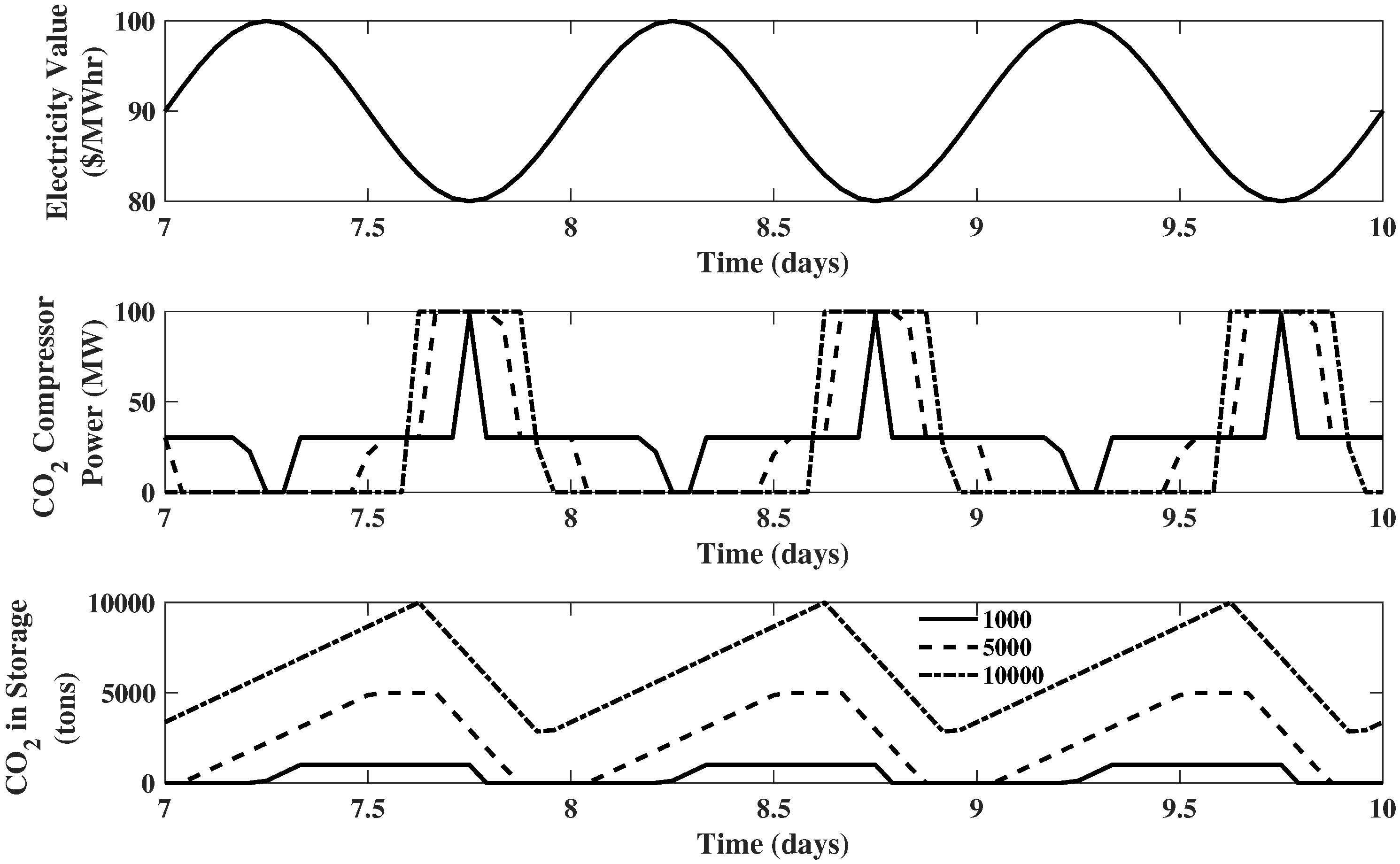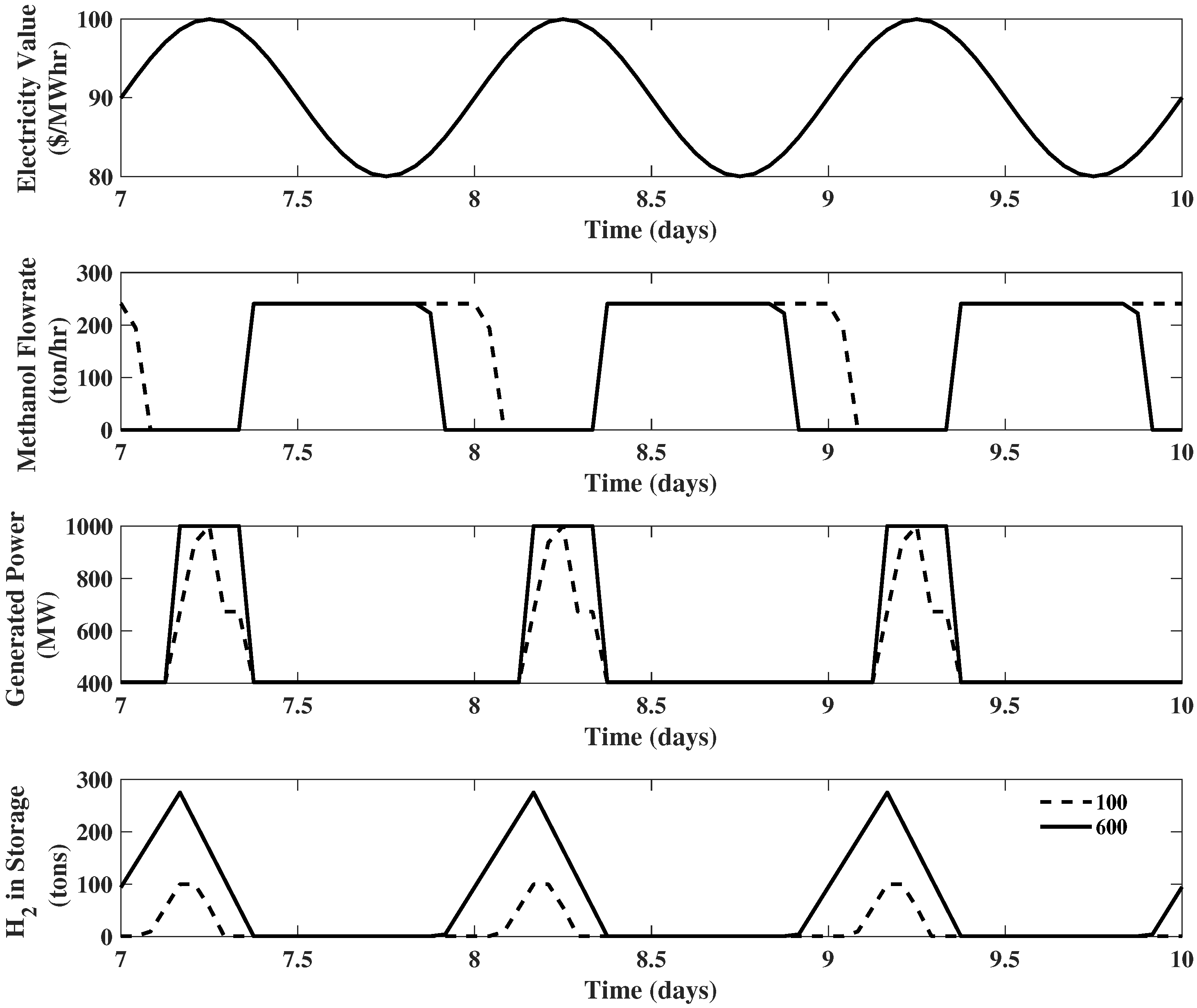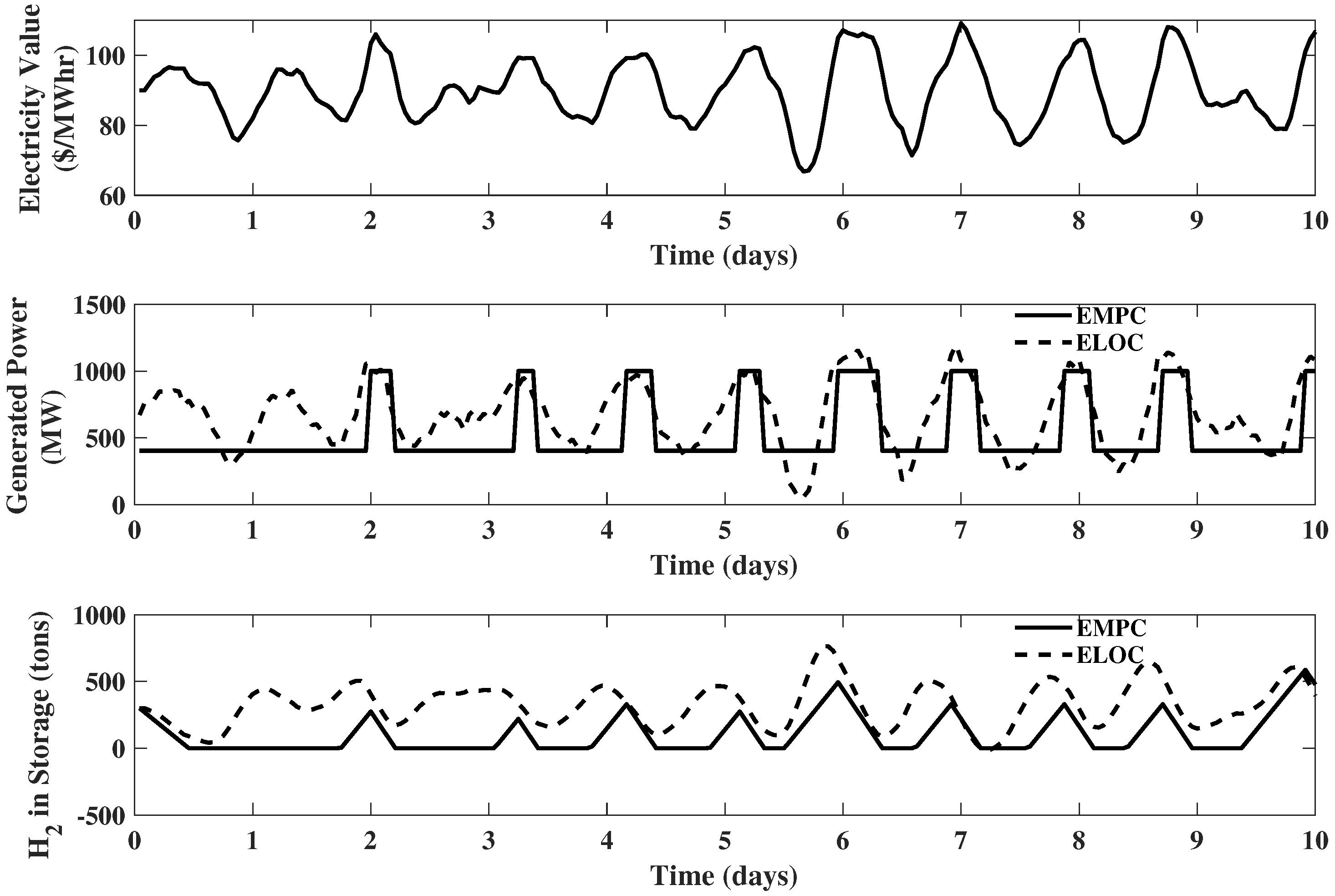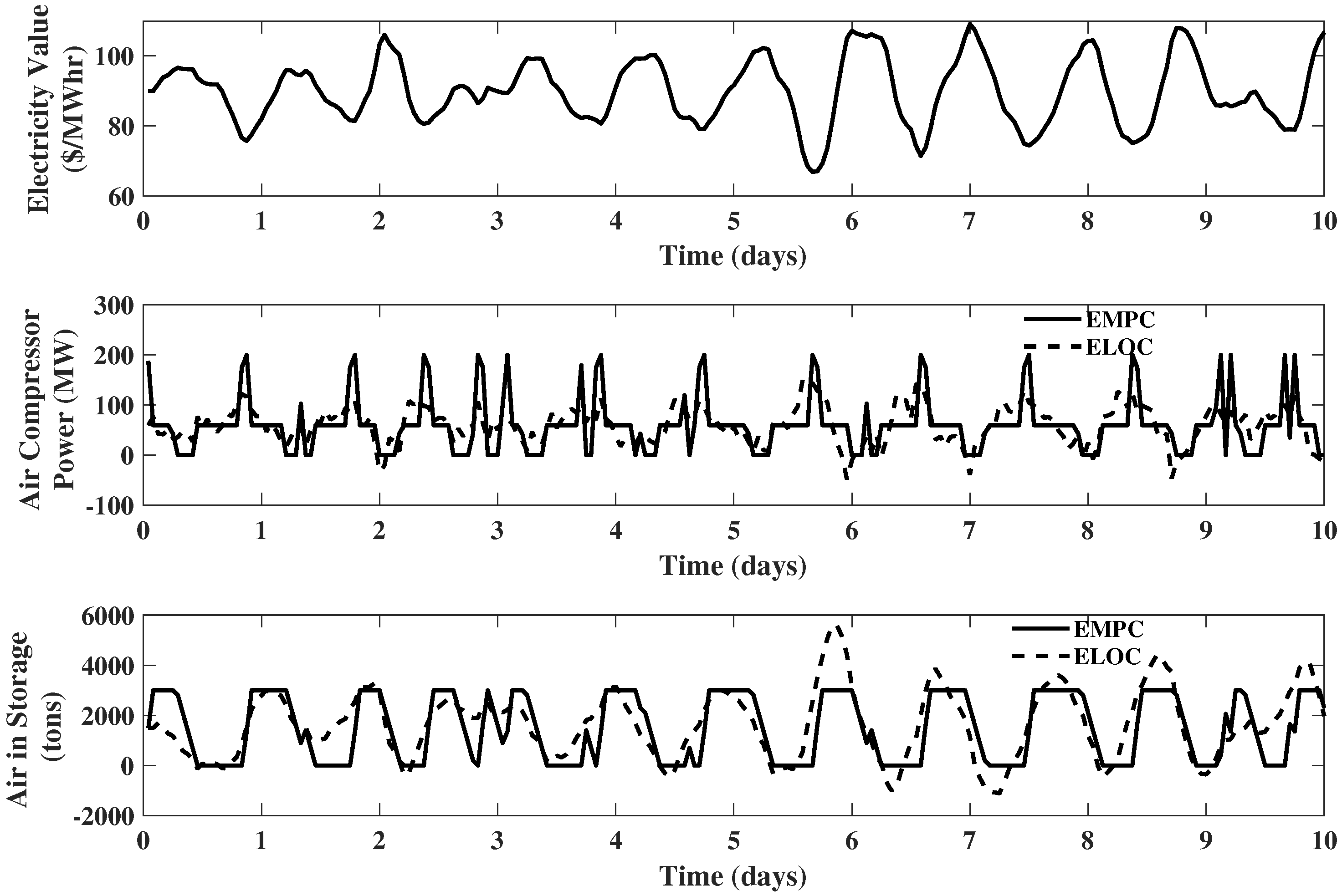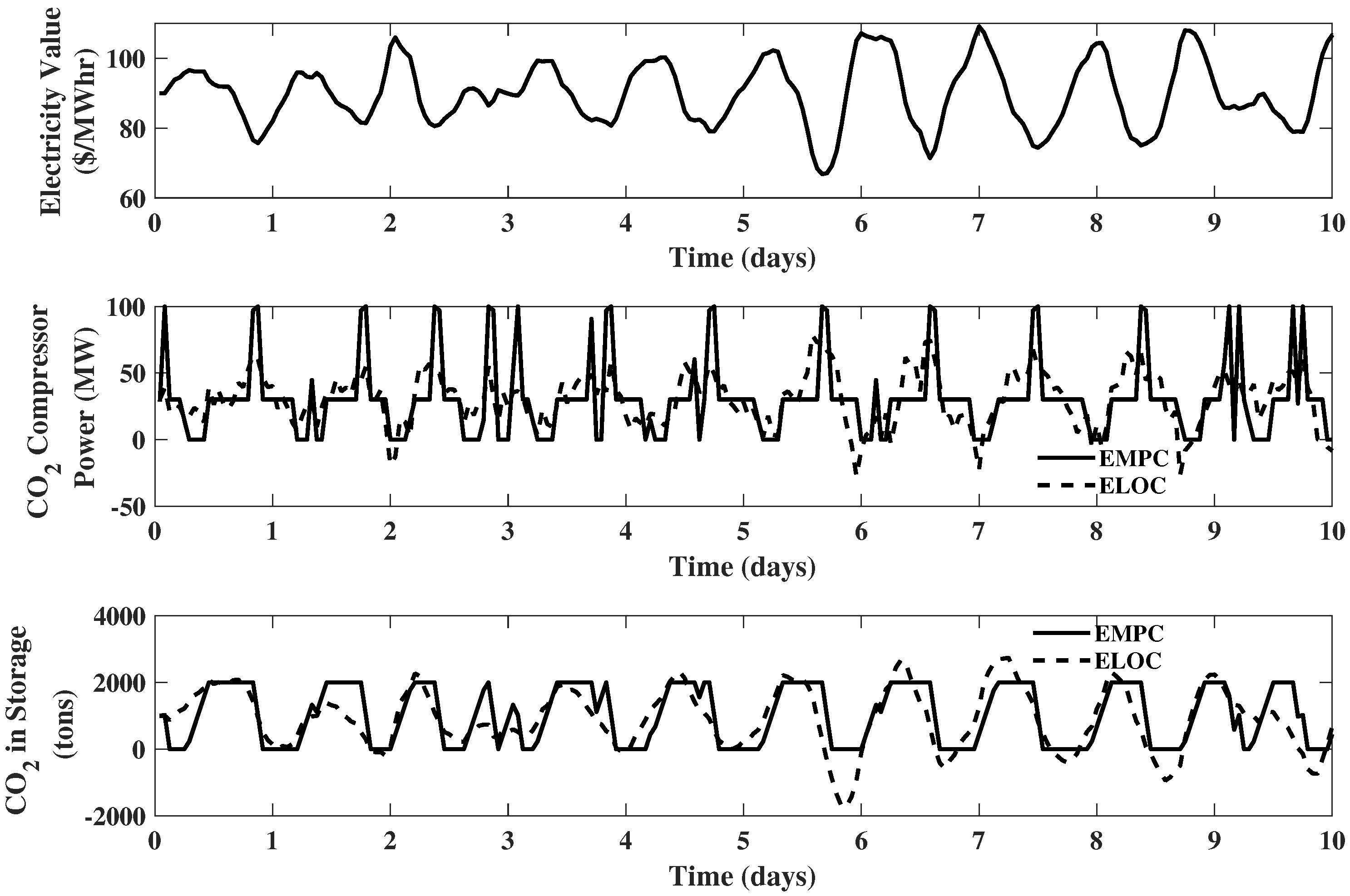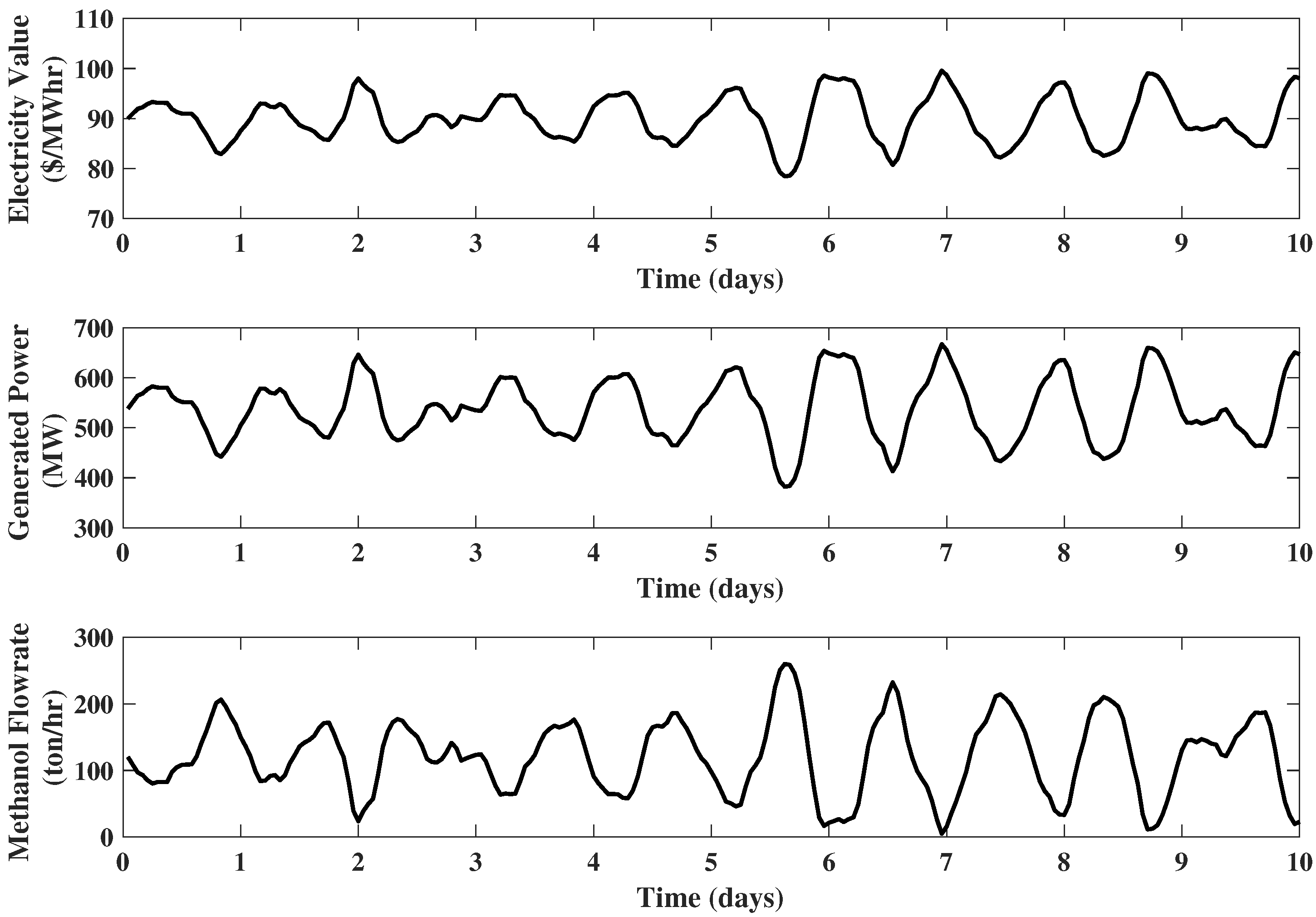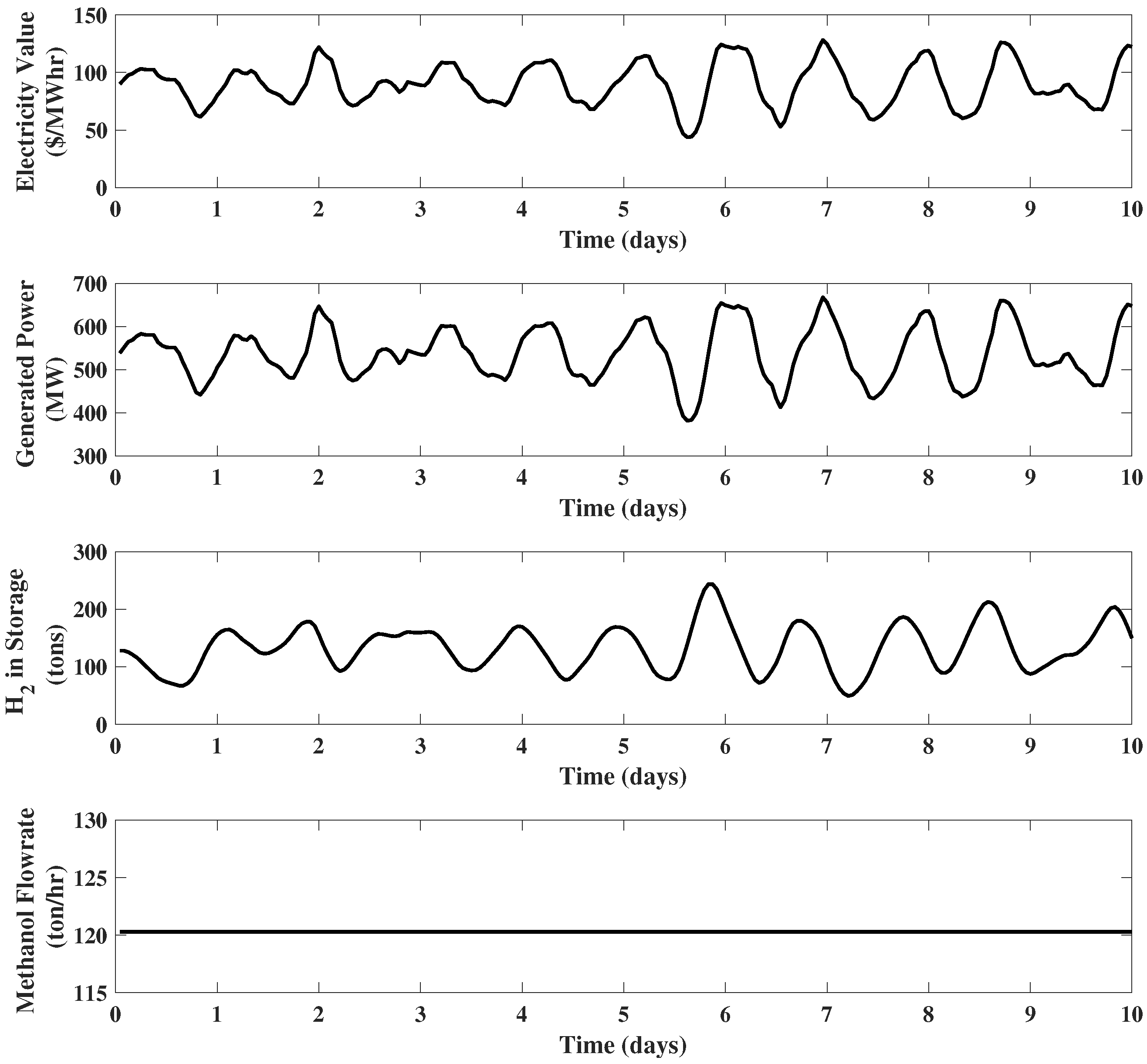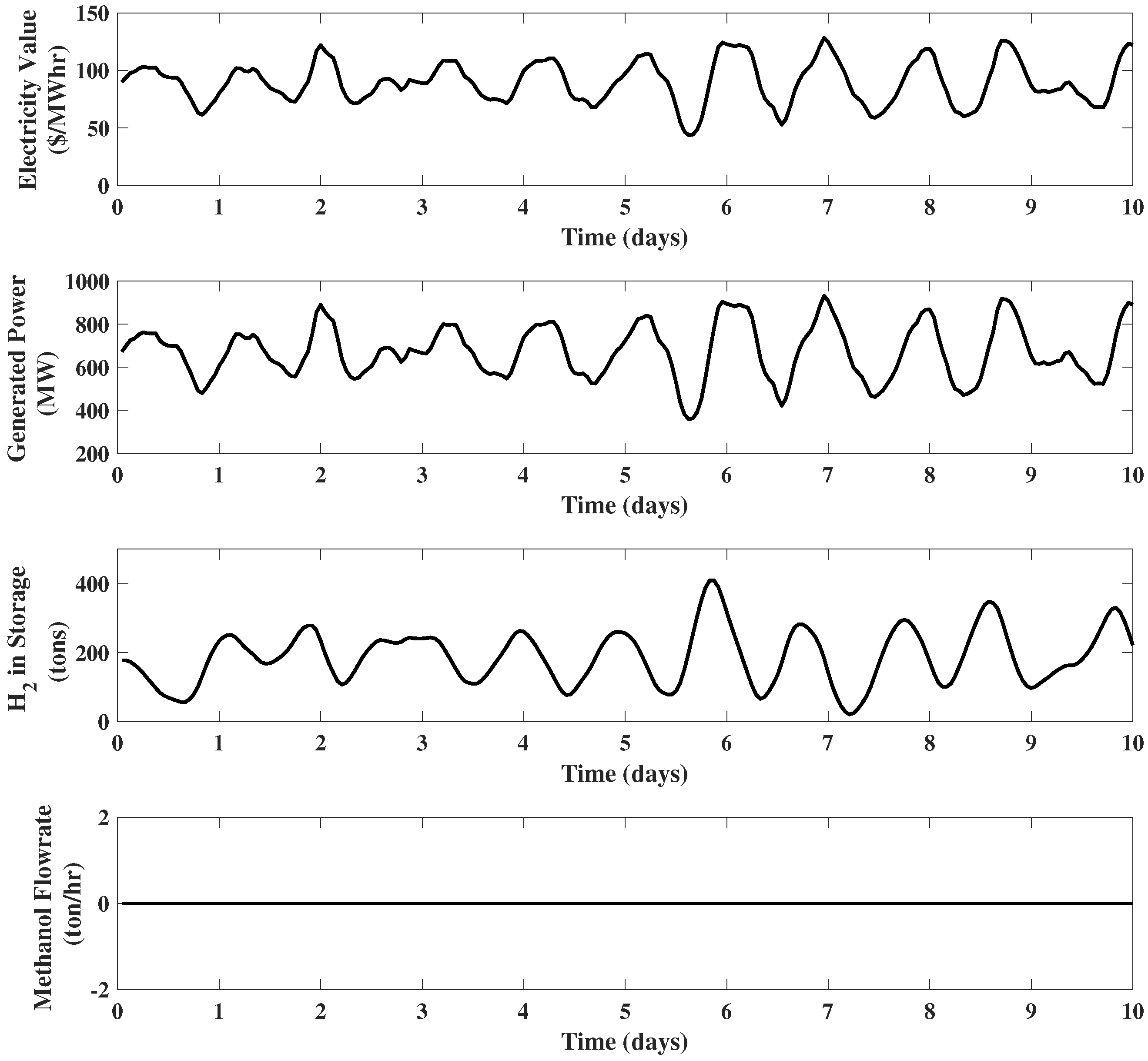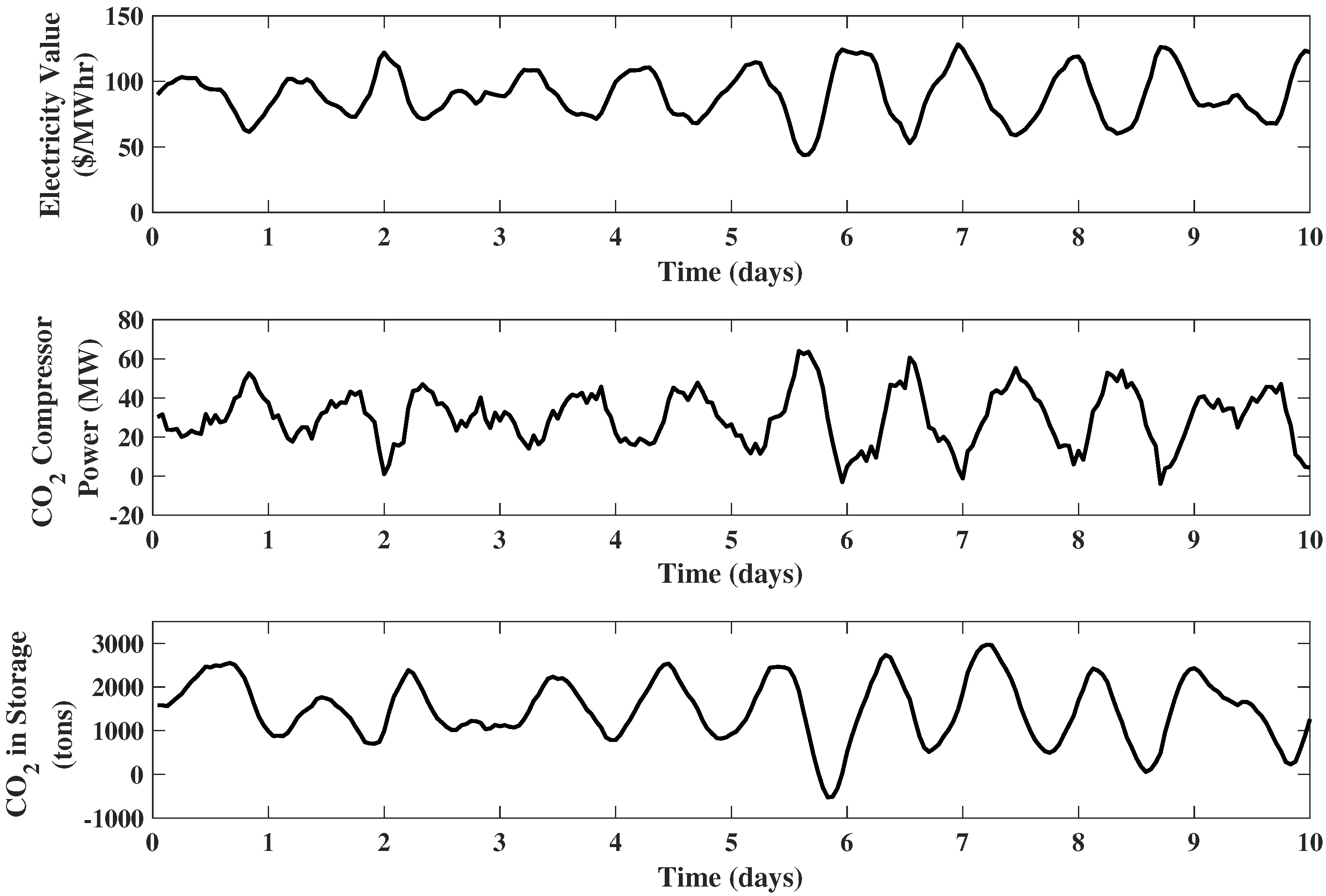Electricity price fluctuations are fundamental to this study and are the primary motivation to develop the IGCC power dispatch system. Subsequent to the establishment of the electricity price model and the dispatch capable IGCC system model, EMPC will be introduced, and its ability to maximize the revenue will be illustrated through examples of the IGCC system with different configurations.
2.1. The Model of Electricity Price
The price of electricity (
) is known to have an oscillatory characteristic of a period of one day. It can be simply modeled as a sinusoidal function for rough analysis. Meanwhile, it can also be modeled as a third order shaping filter to achieve a much more realistic representation. In the latter case, the electricity price can be modeled by the following third order shaping filter [
33]:
where
,
h,
,
h,
is a (to be determined) design parameter,
w is a Gaussian, zero-mean white noise process with spectral density:
and
is the variance of the electricity price.
The reason for the use of this third order shaping filter is that we know electricity price
possesses an oscillatory characteristic of one day, and thus, it can be modeled as the output of an underdamped second order system driven by white noise. However, such a model may allow too much of the low-frequency energy contained in the white noise to pass through to
. Thus, a high pass filter is added to the white noise to remove its low frequency components, which results in the above third order shaping filter. In addition, an important idea about this shaping filter is that, for all parameter values (
,
,
,
, and
), the calculated variance of
through a stochastic covariance analysis of Equation (
4) is always equal to
. If we set
$,
$/(MW h), and
$/
, a realization of
generated from (
4) is given in
Figure 2.
2.2. The Model of the IGCC Power Dispatch System
The process diagram of
Figure 1 illustrates the proposed process modifications. The compressed air storage unit (added between the air compressor and the ASU in the gasification block) allows for independent manipulation of
and
(mass flows of compressed air from the air compressor and to the ASU, respectively) by setting the difference equal to
(the mass flow to the storage unit). The amount of mass in the air storage unit,
, is simply the time integral of
. The hydrogen storage unit and methanol synthesis reactor system (added between the gasification and power generation block) allow for independent manipulation of
,
, and
(mass flows of hydrogen from the gasification block, to the methanol synthesis reactor system, and to the power block, respectively). By setting
(the mass flow to the storage unit), the amount of mass in the hydrogen storage,
, is simply the time integral of
. The carbon dioxide storage added between the gasification block and carbon dioxide compressor allows for independent manipulation of
and
(mass flows of carbon dioxide from the gasification block and to the carbon dioxide compressor, respectively). By setting the difference equal to
(the mass flow to the storage unit), the amount of mass in the carbon dioxide storage unit,
, is simply the time integral of
. The relation between power and mass flow to the air compressor is assumed to be linear
; the relation between mass flows of compressed air and coal to the gasification block is assumed to be
; the relation between mass flows of coal to the gasification block and hydrogen production is assumed to
; the relation between hydrogen mass flow to power block and generated power is assumed to be
; the relation between hydrogen mass flow to the methanol synthesis reactor system and methanol production is assumed to be
; the relation between carbon dioxide production and the mass flow of coal to gasification block is assumed to be
; the relation between the mass flow of compressed carbon dioxide and power to the carbon dioxide compressor is assumed to be
. Finally, the net power generated for the grid is calculated as a simple power balance:
. Converting the above model description into a state-space model yields:
The operating constraints that reflect physical realities and capacity limitations of assumed equipment are as follows:
The following relations can be obtained through a time-average analysis of (
6):
,
, and
, where
,
,
,
, and
are the time-averaged values of
,
,
,
, and
, respectively. There is no limitations imposed by time-average analysis of (
6) on the average mass within the storage. Therefore, we select
,
, and
.
By defining the process state, manipulated, and performance variables as
,
and
, respectively, the system (
6) and (
7) can be written in the following form:
where:
If the data of Case B1B: Shell IGCC Power Plant with
Capture from the NETLBaseline Report [
34] are used (see
Table 1 and
Table 2), the model parameters
can be determined, and their values are shown in
Table 3. The parameter
is obtained based on a methanol synthesis reaction using carbon dioxide and hydrogen as reactants.
Regarding the bounds on
q,
will be treated as a vector of parameters throughout the paper;
will be treated differently depending on the type of optimization problem. In an optimal control problem (
Section 2.3 and
Section 3),
will be treated as a parameter vector with fixed values. In contrast, in the integrated design and control problem (
Section 4),
will become a vector of variables except for its element
. The element
will always have a fixed value, since we assume that the maximum coal flow rate to the gasification block cannot be increased. With
being a vector of variables, its value changes represent the changes to equipment size.
2.3. Economic Model Predictive Control
Consider a process model:
,
, where
s,
m,
p, and
q are state manipulated, disturbance, and performance output vectors, respectively. The process constraints on the performance outputs are
. To implement Model Predictive Control (MPC), the continuous-time model must be converted into discrete-time form. Then, combined with the notion of a predictive time index and economic objective function, the MPC problem is obtained as:
where the index
i represents the actual time of the process and index
k is the predictive time. The idea of MPC is that given an estimate of initial condition,
, at a time
i, and the forecast of disturbances
, a sequence of control actions,
, can be determined by solving the problem (
13). However, only the first control action is used as the input,
, to the process
. Then, at the next time step, the new initial condition
and new disturbance
are estimated based on new measurements. For additional information on MPC, please see [
7].
The only difference between Economic MPC (EMPC) and traditional MPC is the objective function. In traditional MPC, a quadratic objective function is used to track a pre-determined setpoint for process operation, whereas in EMPC, the quadratic objective function is replaced by the operating cost of the process,
. In many cases, the function
is a simple linear function, which has no minimum. Thus, the constraints
are crucial in order to generate a meaningful controller. For additional information on EMPC, please see [
6,
17,
18].
In the EMPC implementation, forecasts of electricity price will be needed. However, to focus on the fundamental issues, this paper will assume the forecast to be perfect, in the sense that they are error free and do not change with time. As such, the “hat” notation in the EMPC formulation will be dropped. This assumption has been shown to be not critical in the evaluation of EMPC in [
16], which investigated EMPC for a simple IGCC power dispatch system with both perfect and imperfect forecasts. For additional information on forecasting, see [
11]. The IGCC plant model developed in
Section 2.2 will be converted to discrete-time form for EMPC implementation, using the sample and hold method (
,
and
) [
35] with a sample time of
h. Regarding the objective function,
denotes electricity price during period
i;
is the price of methanol;
is the cost of coal; the revenue during period
i is
. Thus, the formulation of the EMPC problem for IGCC dispatch is:
where the objective function denotes the average revenue per period
. Clearly, the problem (
18) can be solved using a standard linear programming solver. It should be noted that the final cost term
is not included in the problem (
18). This term is essential to guarantee stability for short horizon EMPC (see [
6,
18]). However, for the current application and with the given horizon, this term plays a less important role and is omitted due to space constraints.
Five examples will be provided to illustrate the ability of EMPC to maximize the revenue for an IGCC power plant with dispatch. For the sake of clarity, the first four examples with increasing complexity of upgrades will use a sinusoidal function to represent the electricity price, whereas the fifth example with fully developed upgrades will employ the shaping filter introduced in
Section 2.1 as the model of electricity price. The corresponding process model for each example can be obtained by proper modification of the IGCC model proposed in
Section 2.2. In addition, the EMPC implemented in all the examples will have a prediction horizon of 24 h with a sample time of 1 h.
Example 1. IGCC plant with only hydrogen storage: The operating conditions of Case B1B of the NETL Baseline Report [34] serve as the basis of all examples. Specifically, the conditions for the IGCC power plant without dispatch are: MW, MW, MW, tons coal/h, tons /h, tons compressed air/h, tons /h, and /ton coal. For the current example, assume only two upgrades are performed. The first is to add a hydrogen storage unit with a capacity of 600 tons ; the second is to increase the size of power block, so that its maximum output is 1000 MW. Moreover, assume that only these two units are capable of dynamic operation and all other units remain at nominal operating conditions. In this case, the state variable is the mass of hydrogen in the storage, , and the manipulated variable is the power generated, . The bounds on the process variables are assumed to be ton , tons , MW (60% of ), and MW. In this scenario, the results of the EMPC using a 24 h prediction horizon are shown in Figure 3. As expected, the manipulated variable, , is at its maximum when the electricity price is high and at its minimum when electricity price is low. The hydrogen storage is filled up during the low electricity value periods and gets discharged during high electricity value intervals. Example 2. IGCC plant with hydrogen storage and compressed air storage: Reconsider the IGCC system of Example 1. Now, in addition to hydrogen storage and power block expansion, two additional upgrades are performed. The first is to add a compressed air storage unit with a capacity of 3000 tons of compressed air; the second is to upgrade the power capacity of the air compressor to 200 MW. In this case, five units are capable of dynamic operations: hydrogen storage, the power block, the air compressor, compressed air storage, and the gasification block ( now assumed to be adjustable). The state variables are , and the manipulated variables are . Regarding the process constraints, ton compressed air, tons compressed air, MW, MW, tons coal/h (60% of ), and tons coal/h.
The results of the EMPC using a 24 h prediction horizon are shown in Figure 4. It is observed that the plots of generated power and hydrogen in storage are quite similar to Example 1. However, the behavior of air compressor is opposite to the power generator. This is because unlike the power generator, which produces electricity, the air compressor consumes electricity. Thus, the electricity consumed by the air compressor increases to its maximum when the electricity price is low and is at its minimum when electricity price is high. The periods at which is at the nominal value ( MW) correspond to intervals in which the compressed air storage is full and the energy value is increasing or the compressed air storage is at its minimum and the energy value is decreasing. This behavior is due to the fact that the controller has no other reasonable option under these conditions, since the production of hydrogen is maintained at its maximum all the time. Example 3. IGCC plant with hydrogen, compressed air and carbon dioxide storages: Assume another two new upgrades are made on the IGCC system of Example 2. The first is to add a carbon dioxide storage unit with a capacity of 2000 tons carbon dioxide; the second is to upgrade the power capacity of carbon dioxide compressor to 100 MW. Then, the state variables become , and the manipulated variables are . In addition to the bounds of Example 2, we also require ton , tons , MW, and MW.
The results of the EMPC using a 24 h prediction horizon are shown in Figure 5. The plots for compressed air storage , hydrogen storage , power consumed by air compressor , generated power , and coal flow rate are omitted, since all of them remain the same as Example 2. Although the carbon dioxide compressor operates at its nominal value ( MW) during the majority of the time, when the electricity price is high, the power consumed by the carbon dioxide compressor will drop to and stay at zero, which means the compressor will be turned off. When the electricity price is low, the carbon dioxide compressor will increase its power consumption to compress more carbon dioxide from the storage. As a result, the storage of carbon dioxide will be fully discharged. This behavior is quite opposite to the compressed air storage. The reason is that unlike the compressed air storage (placed after the air compressor), the carbon dioxide storage is placed before the compressor. During high electricity price periods, the carbon dioxide compressor is turned off, and the carbon dioxide generated from the gasification block will be sent into storage. Then, when electricity price becomes low, and the carbon dioxide coming from both the gasification block and carbon dioxide storage will be compressed.
Example 4. IGCC plant with hydrogen, compressed air, and carbon dioxide storages, as well as a methanol plant: Reconsider the IGCC system of Example 3. Now assume there is another option for the hydrogen stream produced from the gasification block: it can be sent to a methanol synthesis reactor system. The bounds on the methanol production rate are assumed to be ton MeOH/h and tons MeOH/h. Obviously, the price of methanol will directly determine whether it is worth sending the hydrogen to the methanol synthesis reactor. Thus, three cases with different methanol prices are investigated. In all cases, only the plots of methanol flow rate , generated power , and hydrogen in storage will be presented, since the production of hydrogen is always maintained at its maximum, and thus adding the option of methanol production will not affect the optimal operation of other components of IGCC plant, except for power generation and hydrogen storage.
If the selling price of methanol is 100 $/ton, it turns out that no hydrogen is sent to the methanol synthesis reactor system. The reason is that for this price, less revenue will be obtained by selling methanol than selling electricity.
If the price of methanol is increased to 150 $/ton, it is found that now, most of hydrogen is sent to the methanol synthesis reactor, and the power generation stays at its minimum value. This behavior indicates that with this methanol price, it apparently generates more revenue by producing methanol than producing electricity.
Finally, if the selling price of methanol is 110 $/ton, both plants take part in production, as shown in Figure 6. It can be observed that the generated power possesses a behavior similar to previous examples, working at its maximum capacity when the electricity price is high and at its minimum when the electricity price is low. The methanol production reaches a high level when the electricity price is low and drops to zero when the electricity price is high. Example 5. IGCC plant with full upgrades and electricity modeled with the shaping filter: Reconsider the IGCC system of Example 4. Now, assume the electricity price is modeled by the third order shaping filter introduced in Section 2.1 with $, $/(MW h), and $/. The methanol price is set to 110 $/ton. The results of the EMPC are illustrated in Figure 7. It is observed that the electricity price no longer evolves uniformly, and a more realistic performance of the system variables is obtained. 2.4. The Impact of Storage Size
Naturally, it is expected that different storage sizes will result in different optimal control policy. In this subsection, the impact of compressed air storage size, carbon dioxide storage size, and hydrogen storage size will be illustrated through three examples, respectively. All examples use a prediction horizon of 24 h when implementing the EMPC.
Example 6. Reconsider the IGCC system of Example 2. Three cases are studied, each assuming the size of the compressed air storage to be 1000 tons, 5000 tons, and 10,000 tons, respectively. All the other information about the IGCC system remains the same as Example 2.
Comparison of these three cases is illustrated in Figure 8. In all cases, the plots for generated power , hydrogen in storage , and coal flow rate are the same as Example 2 and thus omitted for simplicity. From Figure 8, it is observed that as the compressed air storage size increases, the air compressor will be kept turned off for a longer time when the electricity price is high and will be at its maximum capacity for a longer time when the electricity price is low. Thus, overall, larger compressed air storage will result in better economic performance. This conclusion is supported by the following data: the 10 day revenue obtained from EMPC for these three cases (compressed air storage size being 1000 tons, 5000 tons, and 10000 tons) is $, $, and $, respectively. Example 7. Reconsider the IGCC system of Example 3, but assume the size of the carbon dioxide storage to be 1000 tons, 5000 tons, and 10,000 tons, respectively. All the other information about the hardware of IGCC systems remains unchanged.
In all cases, the plots for generated power , power consumed by air compressor , hydrogen in storage , compressed air in storage , and coal flow rate are the same as Example 3. From Figure 9, a similar behavior is observed: as the carbon dioxide storage increases, the carbon dioxide compressor will be kept turned off for a longer time when the electricity price is high and will be at its maximum capacity for a longer time when the electricity price is low. The 10 day revenue obtained from EMPC for these three cases (carbon dioxide storage size being 1000 tons, 5000 tons, and 10,000 tons) are $, $, and $, respectively. It should be noted that in the 10,000 ton case, the storage is not being fully utilized. Specifically, the storage is never completely emptied, suggesting that the exact same revenue could be achieved with a smaller storage, say 6000 tons. We will see a similar result in the next example.
Example 8. Reconsider the IGCC system of Example 4 with methanol price $/ton MeOH. Now, reduce the hydrogen storage size to 100 tons. All the other information about the IGCC system remains unchanged. From Figure 10, it can be seen that when the hydrogen storage size is reduced to 100 tons, the generated power will stay at its maximum for a much shorter time during the high electricity price periods. Meanwhile, the methanol production will maintain at a high level for a much longer time, and more methanol will be produced. The 10 day revenue obtained from EMPC optimization for these two cases (hydrogen storage size being 100 tons and 600 tons) is $ and $, respectively. It should be noted that despite the fact that the storage size is 600 tons, the optimal operating policy never utilizes all of that storage. In fact, for that case, the exact same revenue would be generated with a storage of about 300 tons. However, if the price of MeOH was reduced to 100 $/ton, then Example 4 indicates all 600 tons of would be utilized.
Thus, it is clear that the equipment size can directly affect the optimal operation of the IGCC system, and larger upgrades will yield to large revenue. However, the capital cost for larger equipment will be larger as well, which naturally leads to the following question: What are the optimal sizes of the hardware units? To answer this question, it requires a net present value assessment that weighs revenue gain against the capital cost of equipment upgrades. Unfortunately, the numeric basis of EMPC indicates that it is ill equipped for use within such an optimization scheme. This is due to the fact that black box numeric simulations are required to estimate revenue as a function of hardware configuration/size. While such an approach can be used within a local search scheme, it is far from sufficient to find global solutions to the non-convex problems that will result from the envisioned IGCC hardware design problem. Therefore, Economic Linear Optimal Control (ELOC) will be proposed as a surrogate for EMPC to perform the net present value analysis. Before diving into the IGCC design problem, first we must prove that ELOC is a appropriate surrogate for EMPC.
